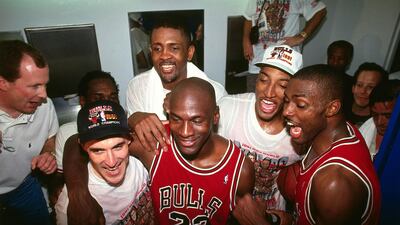Critics will tell you that this is a golden era for television, exploiting the nexus between clever programme producers and the vast platforms that streaming services must populate with original content. In the middle of this golden age for TV, it is also a gilded period for sports documentaries.
Last week, Netflix launched its new film on Pele; last month HBO released its two-part Tiger Woods documentary; and last year it seemed like half the world was in thrall to the amazing story of The Last Dance, the exhaustive retrospective of Michael Jordan's storied basketball career.
Amazon Studios has also kept audiences gripped for years with its All or Nothing seasons, documenting the highs and lows of a string of sporting organisations, including Manchester City, the All Blacks rugby team and the Dallas Cowboys.
While All or Nothing's style is to provide an access-all-areas glimpse into the elite sports world, the more regular sports documentarian's trick is to explore unexpected narrative tension in seemingly well-known stories. Jordan's tale is already in the history books, yet The Last Dance was filled with as many twists and turns as the most recent season of the spy thriller, Killing Eve.
Similarly, the film of Pele's World Cup story delivers narrative surprises to a story that has been told many times.
Arguably the greatest footballer to ever play the game – though fans of the late Diego Maradona, whose story was told with aplomb in Asif Kapadia’s 2019 documentary, will vehemently disagree – the 51 years since Pele’s triumph in the 1970 World Cup have reduced his story to one of destiny delivered in the scorched environs of Mexico City’s Azteca Stadium.
On the contrary, Ben Nicholas and David Tryhorn’s new film reminds us that Pele’s three World Cup triumphs in 1958, 1962 and 1970 were filled with moments of enormous self-doubt and were set against the darkest political clouds at home.
Pele’s struggles have been so effectively sandblasted away over the years that many of us remember him, as the film so beautifully observes, for being “the pioneer of the most fascinating non-goals” in Mexico: the save of the century by England’s Gordon Banks, the shot from inside the Brazilian’s own half that squeaked wide against Czechoslovakia and the outrageous step over that sent the entire world the wrong way in the tournament’s semi-final against Uruguay.
The fact that Pele missed the ensuing shot at an open goal is forgotten in the caricatured presentation of his life that lists his career highlights as the scorer of an improbable 1,000 goals on his way to winning those three World Cups. This new documentary gives us reason to forget his later adventures in celebrity product endorsement, his raucous late 1970s stop at New York Cosmos (for more on that episode, check out Paul Crowder and John Dower's brilliant 2006 film, Once in a Lifetime) and a fondly remembered role in the mess of a film that is Escape to Victory, so that we can wonder at Pele in his pomp once more.
HBO's unauthorised two-parter, Tiger, which is available to stream on OSN, is described as "a revealing look at the rise, fall and epic comeback of a global icon" and was released before the golfer's car crash last month near Los Angeles. Woods is said to be "recovering and in good spirits" after receiving extensive medical treatment for significant injuries to his right ankle and leg sustained in that incident.
The accident, which is still under investigation, may effectively end the golfer's career, and puts the documentary in an unintended light. Set up as providing the first two acts of a three-part dramatic structure, the film bears witness to his rise, spectacular downfall and rise again in 2019. The unwritten third act was meant to deliver more sporting greatness rather than hospitalisation.
That aside, the portrait that emerges of Woods is confusing and compelling. Told through the eyes of those who knew him, but who for the most part no longer speak to him – his former caddy, his high school sweetheart, the woman at the centre of the media storm that engulfed his career in 2009 and so on – their testimony provides answers and questions in near equal measure. The genius of Woods in the winning years was that he could shut the world out as he chased glory on the golf course. Yet this is also presented as the flaw in his programming that propelled him towards serial wrongdoing off it.
I doubt Woods would want or ask for any sympathy, but the vilification he received in the bad years was wildly disproportionate. As Bryant Gumbel, the American broadcaster, eloquently points out, he was judged by different standards to the rest of us.
That he was, is testimony to his spectacular talents and, perhaps, to the bombastic rhetoric that others once used to describe him. Woods’s late father, Earl, played an outsize role in his son’s development from absurdly talented toddler to all-time golfing great and when Woods was on the verge of turning pro in 1996, he said his son would “transcend the game". He also said: "The world will be a better place to live in by virtue of his existence and his presence."
As in the case of Pele, we often forget how good Woods was. It’s time to remember them once more for who they were, not what we thought they became.
Nick March is an assistant editor-in-chief at The National














